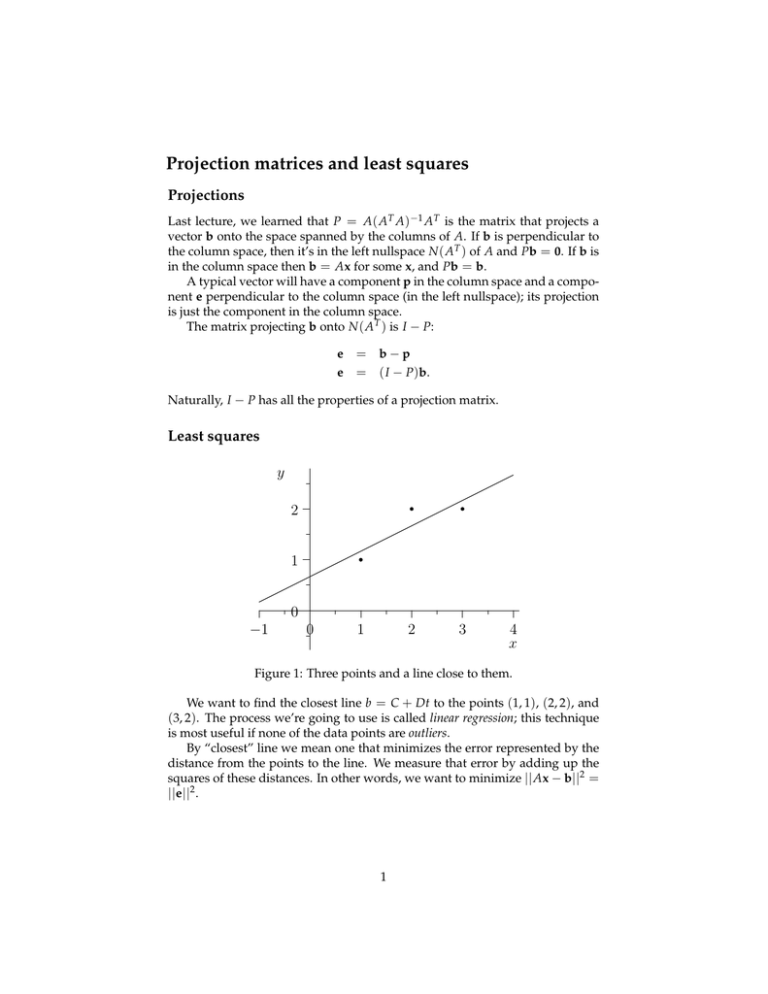Projection Projections =
advertisement

Projection matrices and least squares Projections Last lecture, we learned that P = A( A T A)−1 A T is the matrix that projects a vector b onto the space spanned by the columns of A. If b is perpendicular to the column space, then it’s in the left nullspace N ( A T ) of A and Pb = 0. If b is in the column space then b = Ax for some x, and Pb = b. A typical vector will have a component p in the column space and a compo­ nent e perpendicular to the column space (in the left nullspace); its projection is just the component in the column space. The matrix projecting b onto N ( A T ) is I − P: e e = b−p = ( I − P)b. Naturally, I − P has all the properties of a projection matrix. Least squares y 2 1 0 −1 0 1 2 3 4 x Figure 1: Three points and a line close to them. We want to find the closest line b = C + Dt to the points (1, 1), (2, 2), and (3, 2). The process we’re going to use is called linear regression; this technique is most useful if none of the data points are outliers. By “closest” line we mean one that minimizes the error represented by the distance from the points to the line. We measure that error by adding up the squares of these distances. In other words, we want to minimize || Ax − b||2 = ||e||2 . 1 If the line went through all three points, we’d have: C+D C + 2D = 1 = 2 C + 3D = 2, but this system is unsolvable. It’s equivalent to Ax = b, where: ⎡ ⎤ ⎡ ⎤ � � 1 1 1 C A = ⎣ 1 2 ⎦,x = and b = ⎣ 2 ⎦ . D 1 3 2 There are two ways of viewing this. In the space of the line we’re trying to find, e1 , e2 and e3 are the vertical distances from the data points to the line. The components p1 , p2 and p3 are the values of C + Dt near each data point; p ≈ b. In the other view we have a vector b in R3 , its projection p onto the column space of A, and its projection e onto N ( A T ). � � Ĉ We will now find x̂ = and p. We know: ˆ D � A T Ax̂ �� � 6 Ĉ 14 D̂ 3 6 = �A T b � 5 = . 11 From this we get the normal equations: 3Ĉ + 6D̂ 6Ĉ + 14D̂ = 5 = 11. We solve these to find D̂ = 1/2 and Ĉ = 2/3. We could also have used calculus to find the minimum of the following function of two variables: e12 + e22 + e32 = (C + D − 1)2 + (C + 2D − 2)2 + (C + 3D − 2)2 . Either way, we end up solving a system of linear equations to find that the closest line to our points is b = 23 + 12 t. This gives us: i 1 2 3 � or p = 7/6 5/3 13/6 � � and e = pi 7/6 5/3 13/6 � −1/6 2/6 −1/6 ei −1/6 1/3 −1/6 . Note that p and e are orthogonal, and also that e is perpendicular to the columns of A. 2 The matrix A T A We’ve been assuming that the matrix A T A is invertible. Is this justified? If A has independent columns, then A T A is invertible. To prove this we assume that A T Ax = 0, then show that it must be true that x = 0: A T Ax = x A Ax = ( Ax)T ( Ax) = Ax = T T 0 xT 0 0 0. Since A has independent columns, Ax = 0 only when x = 0. As long as the columns of A are independent, we can use linear regression to find approximate solutions to unsolvable systems of linear equations. The columns of A are guaranteed to be independent i.e. ⎡ ⎤ if⎡they⎤ are orthonormal, ⎡ ⎤ 1 0 0 if they are perpendicular unit vectors like ⎣ 0 ⎦, ⎣ 1 ⎦ and ⎣ 0 ⎦, or like 0 0 1 � � � � cos θ − sin θ and . sin θ cos θ 3 MIT OpenCourseWare http://ocw.mit.edu 18.06SC Linear Algebra Fall 2011 For information about citing these materials or our Terms of Use, visit: http://ocw.mit.edu/terms.







